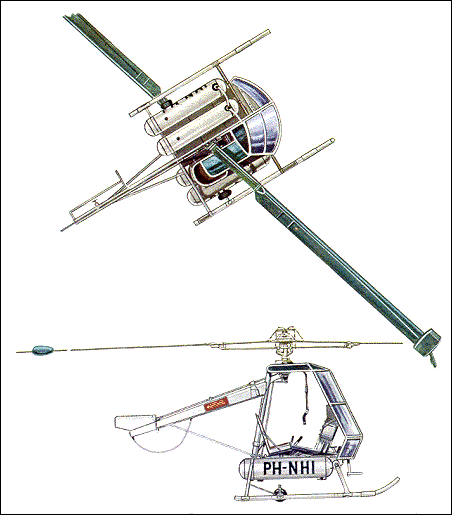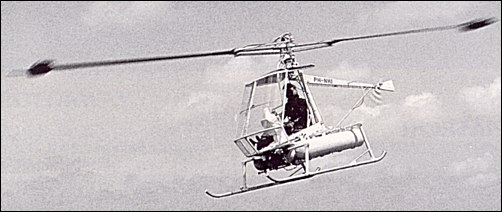|
|
Founded in October, 1955, this company is continuing the helicopter development work started by the SOBEH helicopter foundation, which was formed to design and build an experimental rotary-wing aircraft using a rotor system driven by ramjets. The prototype SOBEH H-2, now known as the NHI H-2, first flew in May, 1955 and was followed in May, 1956 by the first of the developed H-3 Kolibries.
By March, 1958, when the Kolibrie received a Certificate of Airworthiness based on the U.S. requirements for rotorcraft, it had completed 2 1/2 years of flight testing, a 500-hour structural test and a 150-hour engine type-test.
Production of an initial series of ten Kolibries started in 1957, with NHI's two associate companies, Aviolanda and Kromhout, producing the airframes and rotor heads respectively. Kromhout also build the ramjet engines, while the rotor blades are manufactured by Fokker. Deliveries began in March, 1958, the first one going to the Directorate Wieringermeer, which is responsible for the Ijssel-Lake polders. Subsequent deliveries have been made to Western Germany, Wings of Israel, Tel-Aviv, and to the British agents, European Helicopters Ltd., of Ipswich, Suffolk.
Management of NHI was taken over by the Aviolanda company on May 15, 1959.
NHI H-3 KOLIBRIE (HUMMING-BIRD)
The Kolibrie is an extremely-simple two-seat general-purpose helicopter, utilising a ramjet-powered rotor of unique design. Known as a "self-adjusting" rotor, this is somewhat analogous to an automatic variable-pitch airscrew. The blades are so designed that the centre of gravity is ahead of the centre of lift, so that air loads tend to reduce the angle of attack and neutralize disturbances. Static, dynamic, control-force and control-displacement stability have been ensured without the usual damping which reduces manoeuvrability, and no servo mechanism is needed. The aircraft is claimed to be vibration-free.
Use of a see-saw hinge adds to the simplicity of the rotor head, and the two blades are connected by a pack of leaf-springs which takes the place of conventional torsion bearings and flapping hinges. A rigid tube between the blade roots acts as a droop stop and forms a fulcrum about which the blade incidence is changed.
A further important feature of the rotor system is that the rotor has been made considerably larger and heavier than conventional rotors for this class of helicopter. In conjunction with the rotor's high inertia, this results in the accumulation of about twelve times more kinetic rotor-energy for emergencies than in other helicopters.
A wide variety of accessory equipment has been produced to extend the Kolibrie's range of applications, including an under-fuselage cargo-hook with quick-release device for flying crane duties; agricultural spray-gear comprising under-fuselage tanks, pump and spray-booms; dusting and seeding equipment; pontoons and mud-skis; litters that can be carried on the landing gear each side of the cabin; and a "Helicar" trailer which can be used for road transport of the Kolibrie and as a mobile take-off and landing platform.
Type: Light ramjet-powered helicopter.
Rotor System: Two-bladed free-flapping main rotor, with blades of bonded light-alloy construction. Blades connected by pack of leaf springs. Collective-pitch control through rigid tube under rotor. Blade chord 0.25m. Area of each rotor blade 1.093m2. Total main disc area 79.2m2. Single-bladed tail rotor for directional control only, with blade of laminated wood construction. Tail rotor disc area 0.554m2.
Rotor Drive: Main rotor by ramjet engines at blade tips, anti-torque rotor by gear-box and shaft from main rotor. Main rotor r.p.m. (normal) 400. Tail rotor r.p.m. (normal) 2,700.
Fuselage: Duralumin 24 ST central box-beam chassis. Steel rotor pylon. Short rectangular-section tail-boom of light alloy carries tail rotor.
Landing Gear: Metal skids with two ground - handling wheels. No shock-absorbers. Skid track 1.90m. Alternatively, pontoons for amphibious operation.
Power Plant: Two NHI TJ-5 ramjets (each 20kg), burning household-grade kerosene fuel. Each weighs only 9kg and is attached to the rotor blade tip by two bolts, the fuel-line and ignition circuits being connected automatically. One to four cylindrical tanks mounted below body on landing-gear cross struts can be used for fuel and crop-spraying liquid, as required. Maximum fuel capacity (four tanks) 400 litres. A 2hp starting engine can be mounted on rear rotor pylon or can be delivered as a separate item of ground equipment.
Accommodation: Normally two seats. Alternatively, H-3 can be adapted to carry two stretchers, or crop-spraying or seed-sowing equipment, or load-carrying hook (capacity 375kg), or can be fitted with pontoons for over-water flying or swamp-boards. Jane's All the World's Aircraft, 1959-60

The SOBEH Foundation (Stichting voor de Ontwikkeling en Bouw van een Experimenteel Hefschroefvliegting) was established in the early 1950s to research and build small ramjet-powered helicopters designed by J. Meyer Drees. The SOBEH-1 helicopter, which flew in 1954, was an open-frame single-seat machine with a skid undercarriage. Two small ramjets were fitted at the tips of the two-blade rotor, which embodied an automatic pitch adjustment system, and the pilot controlled the machine through a suspended overhead stick The SOBEH-1 was written off through ground resonance, but was succeeded by the SOBEH H-2 (PH-NFT) which was flown in May 1955. The H-2, was an improved version with a large windshield and a tiny strutted tail unit with a small anti-torque propeller. It was taken over by Nederlandse Helicopter Industrie N.V. which was formed by Aviolanda and Kromhout and based at Rotterdam, and they refined the design into the two-seat NHI-3 Kolibri.
The first NHI-3 (PH-NHI) flew in May 1956, and featured a more substantial cabin enclosure and a stronger tail unit. The power units were two 55hp NHI TJ-5 ramjets but these were upgraded to the more powerful 100hp TJ-5A in production aircraft. The main role for the Kolibri was in crop spraying, for which role it had spray tanks mounted beneath the fuselage floorpan with standard spray bars. An initial production batch of ten aircraft was initiated in 1958 for customers in Dutch New Guinea, the United Kingdom, Germany and Israel. Further development of the Kolibri ceased after the company was acquired by Aviolanda in May 1959. R.Simpson "Airlife's Helicopter and Rotorcraft", 1998
Like the "Friendship", the H-3 Kolibrie was an all-Dutch venture, being the joint handiwork of Jan Meijer Drees and Gerard Verhage at the SOBEH (Foundation for the Development and Construction of an Experimental Helicopter) early in 1952. Their objective was to keep the design as simple as possible, and to this end they decided to use ram-jets for power, thus eliminating the need for such complexities as a gearbox or rotor drive shaft. The main drawback to this system was the ram-jet's rather high fuel consumption, although operating costs were kept to a minimum by using domestic paraffin as the basic fuel. Once the ram-jets were ignited this could be fed from any of the four 100-l under-fuselage tanks by centrifugal force.
In May 1955 a prototype of the SOBEH design, the H-2 (registration PH-NFI), was flown for the first time. It had side-by-side seats for a pilot and one passenger behind a large one-piece wind-screen.
In October 1955 the Nederlandse Helicopter Industrie was formed by the Aviolanda and Kromhout companies to build and market the production form of this helicopter, which was known as the H-3 Kolibrie. An H-3 prototype was flown in May 1956 and in 1957 an initial batch of ten production aircraft was laid down, the first three of which were used for certification tests. These machines were powered by two 20kg TJ-5 ram-jets, with a small 2hp auxiliary power unit to spin the rotors up to 70 r.p.m. for ignition. A second batch of ten was begun, these having 23kg TJ-5A ram-jets, but it is not certain whether all of these were completed. Until 1959 the ram-jets and rotor heads were manufactured by Kromhout, but subsequently these units were produced by Aviolanda in addition to the airframes. The rotor blades were built by Fokker. Domestic certification was granted to the Kolibrie in March 1958, delivery taking place to the first two Dutch customers immediately afterwards. Other Kolibries were sold in Germany, Israel and the United Kingdom. The Kolibrie was particularly suitable for agricultural duties, for which it could be fitted with 15.00m spray booms, or for helicopter pilot training. Up to three of the ventral fuel tanks could be replaced by tanks holding chemicals for crop spraying purposes. The H-3 could carry a passenger beside the pilot, or alternatively two stretchers, or a 375kg cargo load slung on an under-fuselage hook. Because of its high fuel consumption the Kolibrie was uneconomical to fly on nonproductive flights, and a special 'helicar' was developed to transport it on such journeys; this vehicle could also be used as a mobile take-off and landing platform. The initial purchase price of the Kolibrie made it one of the world's cheapest helicopters of its day, and it is unfortunate that the sales record was so disappointing. However, its versatility was emphasised by one of those sales, to a scientific expedition which used it for survey and exploration work in New Guinea. K.Munson "Helicopters And Other Rotorcraft Since 1907", 1968
| Technical data for NHI "Kolibri"
Engine: 2 x TJ-5 ramjets, 20kg of thrust each,
main rotor diameter: 10.0m,
tail rotor diameter: 0.84m,
fuselage length: 4.22m,
height: 2.59m,
empty weight: 270kg,
take-off weight: 650kg,
max speed: 113km/h,
max cruising speed: 90km/h,
range (pilot only): 70km
|
Warning: mysqli_connect(): php_network_getaddresses: getaddrinfo for mysql5.zone.ee failed: Name or service not known in /data03/virt15346/domeenid/www.aviastar.org/htdocs/helicopters_eng/nhi_kolibri.php on line 111
Fatal error: Uncaught mysqli_sql_exception: php_network_getaddresses: getaddrinfo for mysql5.zone.ee failed: Name or service not known in /data03/virt15346/domeenid/www.aviastar.org/htdocs/helicopters_eng/nhi_kolibri.php:111
Stack trace:
#0 /data03/virt15346/domeenid/www.aviastar.org/htdocs/helicopters_eng/nhi_kolibri.php(111): mysqli_connect('mysql5.zone.ee', 'd14657sa18989', Object(SensitiveParameterValue))
#1 {main}
thrown in /data03/virt15346/domeenid/www.aviastar.org/htdocs/helicopters_eng/nhi_kolibri.php on line 111
|





